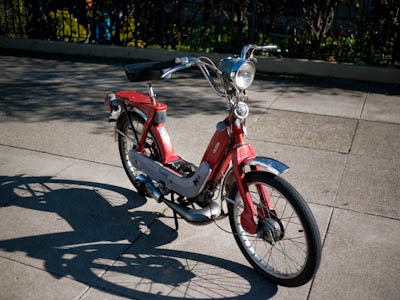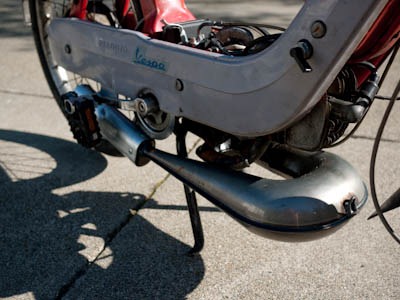
I love San Francisco so much that it’s almost a problem. When I think about taking a trip somewhere, my next thought is, “yeah, but there’s so much awesome stuff going on right here, too.” Of course, no city is perfect. San Francisco’s faults are common to most big cities: parking is a pain traffic gets unwieldy during rush hour.
Enter the moped. I used to think that “moped” was another name for scooter, but it’s not. Considering that mopeds, with a few exceptions, haven’t been mass produced since the 1980s, it’s not all that surprising that no one knows what they are anymore.
A moped is actually a hybrid between a small motorcycle and a bicycle. They were originally designed for the motors to assist in pedaling, not to completely take over. As small engines became more powerful the need for human power diminished and eventually they were replaced with scooters.
If you want a moped these days, you have to buy an old one, usually from the seventies. And if you live in a city, it might be something you should consider. Here’s why:
Parking
Mopeds walk the line between bikes and motorcycles, and in most places get the benefits of each. My moped goes between 40-50 mph at top speed, which means that just like a motorcycle, I can keep up with traffic, go up steep hills, and get places quickly. However, unlike a motorcycle, I can park it absolutely anywhere I want, including sidewalks. I go anywhere I want in San Francisco without even considering parking, and 100% of the time am able to chain the bike up to a street sign or parking meter.
Speed
Like motorcycles, I can drive in between lanes of traffic. That means that if there’s a huge line for a red light, I zoom up to the front and cut the whole line. It’s considered rude if other bikers are in it, but I can also use bike lanes. And, in a pinch, I can even drive slowly on a sidewalk if I need to go the wrong way on a one-way street. I’ve timed myself against friends with cars a few times, and I always get places faster than them, usually 30% faster– and that’s not even factoring in parking.
Fuel Efficiency
Just like the average car driver, I fill up my tank every week. The difference is that I put in about .7 gallons, which comes out to $2 usually. I use the moped as my primary transportation around the city, driving every day, and that covers me. If you happen to run out of gas you can put it into bike mode and pedal it around.
Fun
This is mostly just a summation of the benefits I already mentioned, but together they make the moped a really fun and effortless way to get around. Zipping around the streets, weaving past cars stuck in traffic, and never worrying about parking make it a real joy to get around the city.
Cheap
A totally awesome moped will cost you less than a thousand. I’m selling my old one for $700, but you can buy slow-but-running ones for as low as $400. Parts and upgrades are all pretty cheap, too. A new big carb is $70, a new pipe is $100-200, a 64cc upgrade kit is $150.
Laws vary by state, but you generally don’t have to buy insurance for them. If you have to register them (in some places you don’t), it’s likely to be a one time fee of around $20 for the lifetime of the moped.
The Downsides
People get annoyed (maybe rightly so) when I declare something the best thing ever and then don’t address the downsides. So let’s get to that.
I consider this to be a positive, but since these things are forty years old or so, you can’t exactly bring them to the dealership to get them serviced. You end up doing a lot of the maintenance yourself. Believe it or not, that’s one of the reasons I bought my moped initially; I felt like as a guy/human, I should understand how engines work and be able to work on them.
I went in knowing just about nothing about engines, and now have done all sorts of work, including scary sounding things like replacing the cylinder and piston, replacing the carburetor, and adjusting the brake cables. Maybe most importantly, I have a decent idea of how a two stroke engine works and how all the components work together. Most of this knowledge is thanks to moped enthusiasts at the shops and from mopedarmy.com.
Mopeds have the simplest engines possible, so they’re great to learn on. If you’re not willing to learn, you’d better live near a moped shop. San Francisco and Austin both have excellent ones, but most places don’t.
Which one to Buy?
My moped is a 1974 Vespa Ciao with a 64cc kit, Polini Top One pipe, 13:13 carb, variator, and Red air filter. That’s about as tricked out as a Vespa Ciao can get.
A Vespa Ciao was my only option because I needed something light and small so that I can store it in my RV while driving. It’s a great choice, but a stock Ciao needs to be upgraded before it can handle any sorts of hills. The most popular brand is Puch, and I believe they’re a bit more powerful out of the gate.
The best place to find one is your local Craigslist.


Leave a Reply